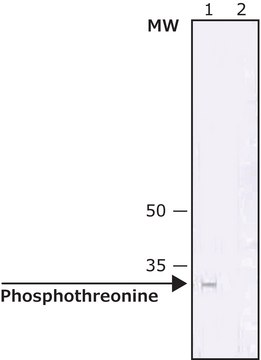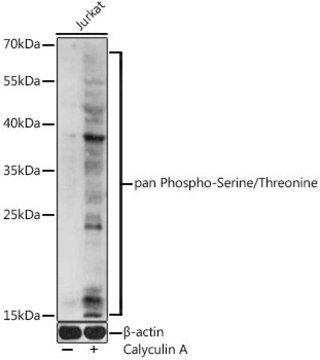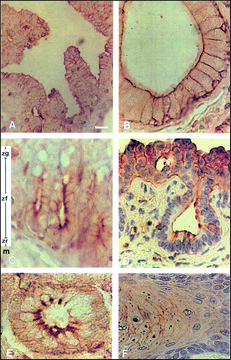06-427
Anti-Phosphotyrosine Antibody
Upstate®, from rabbit
Sign Into View Organizational & Contract Pricing
Select a Size
All Photos(3)
Select a Size
Change View
About This Item
UNSPSC Code:
12352203
eCl@ss:
32160702
NACRES:
NA.41
Recommended Products
biological source
rabbit
Quality Level
antibody form
affinity purified immunoglobulin
antibody product type
primary antibodies
clone
polyclonal
purified by
affinity chromatography
species reactivity
human
species reactivity (predicted by homology)
all (based on 100% sequence homology)
manufacturer/tradename
Upstate®
technique(s)
immunoprecipitation (IP): suitable
western blot: suitable
General description
The phosphorylation of specific tyrosine residues has been shown to be a primary mechanism of signal transduction during normal mitogenesis, cell cycle progression and oncogenic transformation, its role in other areas such as differentiation and gap junction communication, is a matter of active and ongoing research. Antibodies that specifically recognize phosphorylated tyrosine residues have proved to be invaluable to the study of tyrosine phosphorylated proteins and the biochemical pathways in which they function.
Specificity
The immunoreactivity of the antibody is totally inhibited by the use of 100 mM phenyl phosphate, a phosphotyrosine analog. The phosphotyrosine antibody is purified by immunoaffinity chromatography using either a dual phospho-peptide gel or a BSA-phosphotyrosine gel. All of the phosphotyrosine immunoreactivity present in the antisera is immunoadsorbed whether the antibody is purified by either gel indicating that the antibody is not sequence-specific but specific for phosphotyrosine residues.
Immunogen
In order to produce broad spectrum polyclonal phosphotyrosine antibodies, rabbits were immunized with three phosphorylated immunogens: (1) phosphotyrosine covalently linked to KLH; (2) the c-Src carboxyl terminal regulatory phosphopeptide (TS-T-E-P-Q-pY-Q-P-G-E-N-L; Catalog # 12-218) covalently linked to KLH, and; (3) a phosphopeptide associated with high tyrosine kinase activity in human lymphocytes (R-R-L-I-E-D-A-E-pY-A-A-R-G; Catalog # 12-217) covalently linked to KLH. Both of the phosphopeptide haptens serve as strong substrates for tyrosine phosphatases and are part of the two colorimetric tyrosine phosphatase kits provided by Upstate, Inc. (Catalog # 17-125, 17-126).
Application
Anti-Phosphotyrosine Antibody detects level of Phosphotyrosine & has been published & validated for use in IP & WB.
Research Category
Signaling
Signaling
Research Sub Category
General Post-translation Modification
Signaling Neuroscience
General Post-translation Modification
Signaling Neuroscience
Western Blotting Analysis: A 1:500 dilution from a representative lot detected Phosphotyrosine in 10 µg of EGF treated A431 with Lambda Phosphatase tissue lysate.
Immunoprecipitation Analysis: 5 µL from a representative lot immunoprecipitated Phosphotyrosine in 0.5 mg of EGF treated A431 cell lysate
Immunoprecipitation Analysis: 5 µL from a representative lot immunoprecipitated Phosphotyrosine in 0.5 mg of EGF treated A431 cell lysate
Quality
Evaluated by Western Blotting in EGF treated A431 cell lysate.
Western Blotting Analysis: A 1:500 dilution of this antibody detected Phosphotyrosine in 10 µg of EGF treated A431 cell lysate.
Western Blotting Analysis: A 1:500 dilution of this antibody detected Phosphotyrosine in 10 µg of EGF treated A431 cell lysate.
Target description
Varies
Physical form
Affinity purified
Purified rabbit polyclonal in buffer containing 0.1 M Tris-Glycine (pH 7.4), 150 mM NaCl with 0.05% sodium azide.
Storage and Stability
Stable for 1 year at 2-8°C from date of receipt.
Analysis Note
Control
Positive Antigen Control: Catalog #12-302, EGF-stimulated A431 cell lysate. Add 2.5µL of 2-mercaptoethanol/100µL of lysate and boil for 5 minutes to reduce the preparation. Load 20µg of reduced lysate per lane for minigels.
Positive Antigen Control: Catalog #12-302, EGF-stimulated A431 cell lysate. Add 2.5µL of 2-mercaptoethanol/100µL of lysate and boil for 5 minutes to reduce the preparation. Load 20µg of reduced lysate per lane for minigels.
Other Notes
Concentration: Please refer to the Certificate of Analysis for the lot-specific concentration.
Legal Information
UPSTATE is a registered trademark of Merck KGaA, Darmstadt, Germany
Disclaimer
Unless otherwise stated in our catalog or other company documentation accompanying the product(s), our products are intended for research use only and are not to be used for any other purpose, which includes but is not limited to, unauthorized commercial uses, in vitro diagnostic uses, ex vivo or in vivo therapeutic uses or any type of consumption or application to humans or animals.
Not finding the right product?
Try our Product Selector Tool.
recommended
Product No.
Description
Pricing
wgk_germany
WGK 1
flash_point_f
does not flash
flash_point_c
does not flash
Certificates of Analysis (COA)
Search for Certificates of Analysis (COA) by entering the products Lot/Batch Number. Lot and Batch Numbers can be found on a product’s label following the words ‘Lot’ or ‘Batch’.
Already Own This Product?
Find documentation for the products that you have recently purchased in the Document Library.
Our team of scientists has experience in all areas of research including Life Science, Material Science, Chemical Synthesis, Chromatography, Analytical and many others.
Contact Technical Service








